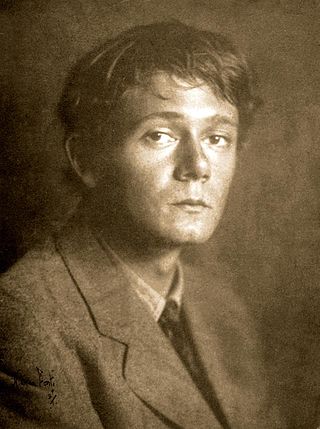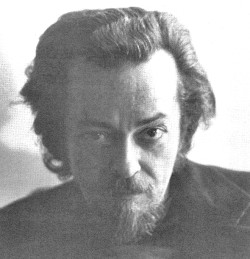Related Research Articles

The Cthulhu Mythos is a mythopoeia and a shared fictional universe, originating in the works of American horror writer H. P. Lovecraft. The term was coined by August Derleth, a contemporary correspondent and protégé of Lovecraft, to identify the settings, tropes, and lore that were employed by Lovecraft and his literary successors. The name "Cthulhu" derives from the central creature in Lovecraft's seminal short story "The Call of Cthulhu", first published in the pulp magazine Weird Tales in 1928.

Clark Ashton Smith was an American writer and artist. He achieved early local recognition, largely through the enthusiasm of George Sterling, for traditional verse in the vein of Swinburne. As a poet, Smith is grouped with the West Coast Romantics alongside Joaquin Miller, Sterling, and Nora May French and remembered as "The Last of the Great Romantics" and "The Bard of Auburn". Smith's work was praised by his contemporaries. H. P. Lovecraft stated that "in sheer daemonic strangeness and fertility of conception, Clark Ashton Smith is perhaps unexcelled", and Ray Bradbury said that Smith "filled my mind with incredible worlds, impossibly beautiful cities, and still more fantastic creatures".

The Necronomicon, also referred to as the Book of the Dead, or under a purported original Arabic title of Kitab al-Azif, is a fictional grimoire appearing in stories by the horror writer H. P. Lovecraft and his followers. It was first mentioned in Lovecraft's 1924 short story "The Hound", written in 1922, though its purported author, the "Mad Arab" Abdul Alhazred, had been quoted a year earlier in Lovecraft's "The Nameless City". Among other things, the work contains an account of the Old Ones, their history, and the means for summoning them.
Arkham House is an American publishing house specializing in weird fiction. It was founded in Sauk City, Wisconsin, in 1939 by August Derleth and Donald Wandrei to publish hardcover collections of H. P. Lovecraft's best works, which had previously been published only in pulp magazines. The company's name is derived from Lovecraft's fictional New England city, Arkham, Massachusetts. Arkham House editions are noted for the quality of their printing and binding. The colophon for Arkham House was designed by Frank Utpatel.

Azathoth is a deity in the Cthulhu Mythos and Dream Cycle stories of writer H. P. Lovecraft and other authors. He is the ruler of the Outer Gods, and may be seen as a symbol for primordial chaos.

Tsathoggua is a supernatural entity in the Cthulhu Mythos shared fictional universe. He is the creation of American writer Clark Ashton Smith and is part of his Hyperborean cycle.

Linwood Vrooman Carter was an American author of science fiction and fantasy, as well as an editor, poet and critic. He usually wrote as Lin Carter; known pseudonyms include H. P. Lowcraft and Grail Undwin. He is best known for his work in the 1970s as editor of the Ballantine Adult Fantasy series, which introduced readers to many overlooked classics of the fantasy genre.
The Hyperborean cycle is a series of short stories by Clark Ashton Smith that take place in the fictional prehistoric setting of Hyperborea. Smith's cycle takes cues from his friends, H. P. Lovecraft and Robert E. Howard and their works. Lovecraft wrote to Smith in a letter dated 3 December 1929: "I must not delay in expressing my well-nigh delirious delight at The Tale of Satampra Zeiros [Smith's short story]... [W]hat an atmosphere! I can see & feel & smell the jungle around immemorial Commoriom, which I am sure must lie buried today in glacial ice near Olathoe, in the Land of Lomar!". Soon afterward, Lovecraft included Smith's Tsathoggua in the story "The Mound", ghostwritten for Zealia Bishop in December 1929. Lovecraft also mentioned Tsathoggua in "The Whisperer in Darkness", which he began on February 24, 1930, and in "At the Mountains of Madness" a year later, along with the Hyperborean cities of Commoriom and Uzuldaroum. Because Smith in turn borrowed numerous Lovecraftian elements, the cycle itself may be regarded as a branch of the Cthulhu Mythos. In a letter to August Derleth dated 26 July 1944, Smith wrote: "In common with other weird tales writers, I have ... made a few passing references to some of the Lovecraftian deities. My Hyperborean tales, it seems to me, with their primordial, prehuman and sometimes premundane background and figures, are the closest to the Cthulhu Mythos, but most of them are written in a vein of grotesque humor that differentiates them vastly. However, such a tale as "The Coming of the White Worm" might be regarded as a direct contribution to the Mythos.".

Lovecraftian horror, sometimes used interchangeably with "cosmic horror", is a subgenre of horror fiction and weird fiction that emphasizes the horror of the unknowable and incomprehensible more than gore or other elements of shock. It is named after American author H. P. Lovecraft (1890–1937). His work emphasizes themes of cosmic dread, forbidden and dangerous knowledge, madness, non-human influences on humanity, religion and superstition, fate and inevitability, and the risks associated with scientific discoveries, which are now associated with Lovecraftian horror as a subgenre. The cosmic themes of Lovecraftian horror can also be found in other media, notably horror films, horror games, and comics.
"The Festival" is a short story by H. P. Lovecraft written in October 1923 and published in the January 1925 issue of Weird Tales.

The Whisperer in Darkness is a 26,000-word novella by American writer H. P. Lovecraft. Written February–September 1930, it was first published in Weird Tales, August 1931. Similar to The Colour Out of Space (1927), it is a blend of horror and science fiction. Although it makes numerous references to the Cthulhu Mythos, the story is not a central part of the mythos, but reflects a shift in Lovecraft's writing at this time towards science fiction. The story also introduces the Mi-Go, an extraterrestrial race of fungoid creatures.
A Cthulhu Mythos anthology is a type of short story collection that contains stories written in, or related to, the Cthulhu Mythos genre of horror fiction launched by H. P. Lovecraft. Such anthologies have helped to define and popularize the genre.
Necronomicon Press is an American small press publishing house specializing in fiction, poetry and literary criticism relating to the horror and fantasy genres. It is run by Marc A. Michaud.

Beyond the Wall of Sleep is a collection of fantasy, horror and science fiction short stories, poems and essays by American author H. P. Lovecraft. It was released in 1943 and was the second collection of Lovecraft's work published by Arkham House. 1,217 copies were printed. The volume is named for the Lovecraft short story "Beyond the Wall of Sleep".

Out of Space and Time is a collection of fantasy, horror and science fiction short stories by American writer Clark Ashton Smith. It was released in 1942 and was the third book published by Arkham House. 1,054 copies were printed. A British hardcover appeared from Neville Spearman in 1971, with a two-volume paperback reprint following from Panther Books in 1974. Bison Books issued a trade paperback edition in 2006.
"History of the Necronomicon" is a short text written by H. P. Lovecraft in 1927, and published in 1938. It describes the origins of the fictional book of the same name: the occult grimoire Necronomicon, a now-famous element of some of his stories. The short text purports to be non-fiction, adding to the appearance of "pseudo-authenticity" which Lovecraft valued in building his Cthulhu Mythos oeuvre. Accordingly, it supposes the history of the Necronomicon as the inspiration for Robert W. Chambers' The King in Yellow, which concerns a book that overthrows the minds of those who read it.
Crypt of Cthulhu is an American fanzine devoted to the writings of H. P. Lovecraft and the Cthulhu Mythos. It was published as part of the Esoteric Order of Dagon amateur press association for a short time, and was formally established in 1981 by Robert M. Price, who edited it throughout its subsequent run.
References
- ↑ Smith, Don G. (2006). H.P. Lovecraft in Popular Culture. Jefferson, NC: McFarland & Company. p. 32. ISBN 978-0-7864-2091-9.
- ↑ Steve Behrends. Clark Ashton Smith (Starmont Reader's Guide 49). Mercer Is, WA: Starmont House, 1990, pp 67-68.
- ↑ Mitchell, Charles P. (2001). The Complete H.P. Lovecraft Filmography. Greenwood Publishing Group. p. 6. ISBN 0-313-31641-4.
- ↑ This is incorrect, however, since Frank Belknap Long included a quote from the Necronomicon in his The Space-Eaters in 1928.
- ↑ Prescott, Orville (31 January 1945). "Books of the Times". The New York Times .
- ↑ Field, Louise Maunsell (9 August 1942). "Tales of Horror: Out of Space and Time". The New York Times .
- ↑ Colavito, Jason (2008). Knowing Fear: Science, Knowledge and the Development of the Horror Genre. Jefferson, N.C.: McFarland & Company. p. 193. ISBN 978-0-7864-3273-8.
- ↑ "CLARK ASHTON SMITH'S, RETURN OF THE SORCERER – READY BY ANTHONY D. P. MANN, SCORE BY SEIZON". Cadabra Records. 2018-04-27. Retrieved 2018-05-17.
- ↑ "Anthony D.P. Mann". IMDb. Retrieved 2018-05-17.
- ↑ "Return of the Sorcerer (LP), by Seizon". Seizon. Retrieved 2018-05-17.